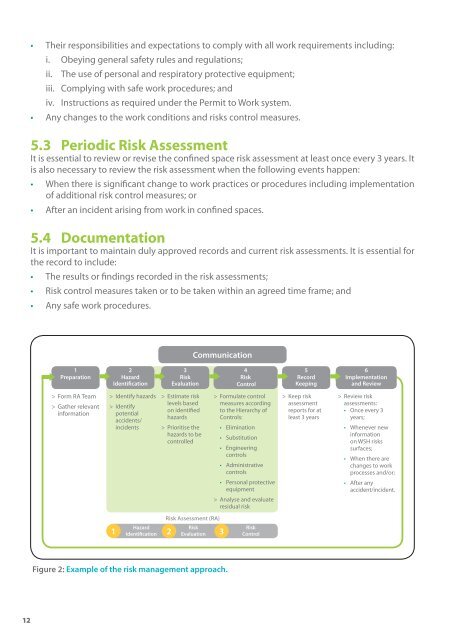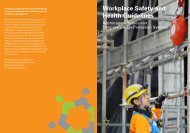Confined Spaces - Workplace Safety and Health Council
Confined Spaces - Workplace Safety and Health Council
Confined Spaces - Workplace Safety and Health Council
- No tags were found...
Create successful ePaper yourself
Turn your PDF publications into a flip-book with our unique Google optimized e-Paper software.
• Their responsibilities <strong>and</strong> expectations to comply with all work requirements including:i. Obeying general safety rules <strong>and</strong> regulations;ii. The use of personal <strong>and</strong> respiratory protective equipment;iii. Complying with safe work procedures; <strong>and</strong>iv. Instructions as required under the Permit to Work system.• Any changes to the work conditions <strong>and</strong> risks control measures.5.3 Periodic Risk AssessmentIt is essential to review or revise the confined space risk assessment at least once every 3 years. Itis also necessary to review the risk assessment when the following events happen:• When there is significant change to work practices or procedures including implementationof additional risk control measures; or• After an incident arising from work in confined spaces.5.4 DocumentationIt is important to maintain duly approved records <strong>and</strong> current risk assessments. It is essential forthe record to include:• The results or findings recorded in the risk assessments;• Risk control measures taken or to be taken within an agreed time frame; <strong>and</strong>• Any safe work procedures.Communication6. Types of Hazards in <strong>Confined</strong> <strong>Spaces</strong>Many hazards can exist in confined spaces. In general, hazards that can occur in non-confinedspaces can also occur in confined spaces. It is important to note this point. The characteristics ofa confined space usually aggravate or intensify many of these hazards.The most dangerous hazards in confined spaces (see Section 4.3 Types of Injury) are associatedwith the atmosphere contained within them. The atmosphere inside different confined spacesvaries depending on the type of space, the work being done inside, <strong>and</strong> what was previouslycontained or stored in them. However, the most common atmospheric hazards found in confinedspaces can be broadly classified into:• Suffocation (or asphyxiation) hazards — due to oxygen deficiency;• Fire/Explosion hazards — due to presence of flammable gases <strong>and</strong> vapours; <strong>and</strong>• Poisoning — due to presence of toxic gases, vapours or fumes.6.1 Suffocation Hazards — By Oxygen DeficiencyThe air in our natural environment contains 20.9 % oxygen.An environment is considered oxygen deficient when the concentration of oxygen is less than19.5 % by volume. The effects <strong>and</strong> symptoms of different levels of oxygen deficiency on humansare described below.1Preparation> Form RA Team> Gather relevantinformation2HazardIdentification> Identify hazards> Identifypotentialaccidents/incidentsHazardIdentification3RiskEvaluation> Estimate risklevels basedon identifiedhazards> Prioritise thehazards to becontrolledRisk Assessment (RA)RiskEvaluation1 2 34RiskControl> Formulate controlmeasures accordingto the Hierarchy ofControls:• Elimination• Substitution• Engineeringcontrols• Administrativecontrols• Personal protectiveequipment> Analyse <strong>and</strong> evaluateresidual riskRiskControl5RecordKeeping> Keep riskassessmentreports for atleast 3 years6Implementation<strong>and</strong> Review> Review riskassessments:• Once every 3years;• Whenever newinformationon WSH riskssurfaces;• When there arechanges to workprocesses <strong>and</strong>/or;• After anyaccident/incident.Oxygen concentration, volume %Effects <strong>and</strong> symptoms19.5 Minimum safe entry level16 – 19 Poor coordination, fatigue12 – 16 Rapid pulse, difficulty in breathing10 – 12Very fast <strong>and</strong> deep breathing, lips begin toturn blue, headache8 – 10Fainting, unconsciousness, nausea,vomiting6 – 8 Fatal in 8 minutes; 50% fatal in 6 minutes< 6Coma in 1 minute, convulsions, respiratory<strong>and</strong> cardiac arrest, deathFigure 2: Example of the risk management approach.Table 1: The effects <strong>and</strong> symptoms of different levels of oxygen deficiency on humans.12 13
















